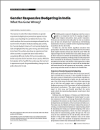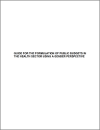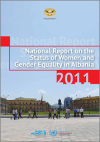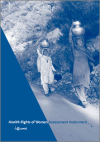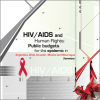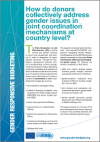FOUND 203
The article examines the two main strategies adopted by the Government of India for institutionalizing gender responsive budgeting to highlight what has gone wrong and what needs to be fixed in order to achieve better outcomes for women.
This publication supports the design and formulation of Gender Sensitive policies and budgets in the Health Sector.
The gender budgeting guidelines for girls' education were developed by the Ethiopian Minsitry of Finance and Ministry of Education in 2009 to provide guidance to planners and budget experts in their decision making in resource allocation to achieve girls' equal access to education at all levels.
The publication serves as a basic manual for collecting data, assessing gender equality and the status of women in Albania and developing proposals to further improve them in such areas as women’s participation in the decision-making, education, employment, defense, social welfare, health, media and
The Health Rights of Women Assessment Instrument (HeRWAI) is a tool developed by the Humanist Committee on Human Rights (HOM) in 2006 to enhance lobbying activities for better implementation of women's health rights.
This study of HIV/AIDS, human rights and budgets in five Latin American countries (Argentina, Chile, Ecuador, Mexico and Nicaragua) was prepared by Fundar Centro de An¡lisis e Investigaci, October 2004.
The Paris Declaration on Aid Effectiveness (PD) commits donors and partner countries to reform aid management and delivery in order to strengthen its development outcomes.
This synthesis paper examines the evolution of efforts to address domestic violence in Latin America. In the outset, the authors elucidate the methodological dilemmas involved in collecting data on domestic violence. The paper discusses some of the outcom
This synthesis paper examines the evolution of efforts to address domestic violence in Latin America. In the outset, the authors elucidate the methodological dilemmas involved in collecting data on domestic violence.
This synthesis paper examines the evolution of efforts to address domestic violence in Latin America. In the outset, the authors elucidate the methodological dilemmas involved in collecting data on domestic violence. The paper discusses some of the outcom
